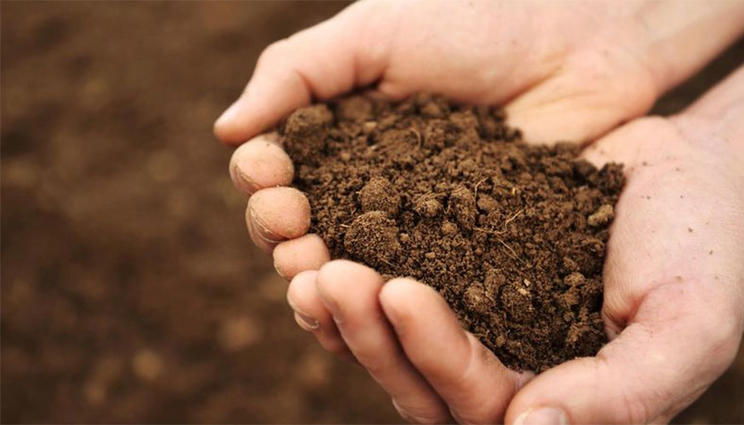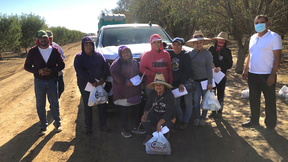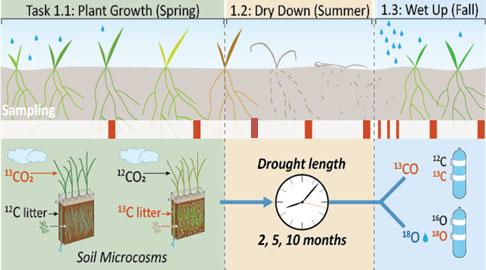LLNL researchers to study soil microbiome
 (Download Image)
Soil and associated organic molecules are crucial to agriculture, healthy ecosystems and the planet’s climate. LLNL researchers will study this process in the new Soil Microbiome Scientific Focus Area initiative. Credit: blueenayim/iStock
(Download Image)
Soil and associated organic molecules are crucial to agriculture, healthy ecosystems and the planet’s climate. LLNL researchers will study this process in the new Soil Microbiome Scientific Focus Area initiative. Credit: blueenayim/iStock
A new Lawrence Livermore National Laboratory (LLNL) initiative to study how the soil microbiome (microorganisms such as fungi and bacteria, microfauna and viruses) controls the mechanisms that regulate organic matter stabilization in soil can move forward after the Department of Energy’s (DOE) Office of Biological and Environmental Research awarded an LLNL team $2.5 million per year for the next 3-5 years.
The project’s premise is that the soil microbiome has a major effect on the size and longevity of the soil carbon pool, and thus affects soil fertility, water-holding capacity and the planet’s carbon cycle.
LLNL’s unique mass spectrometry and isotope tracing tools will be used to trace microbes and their cell materials (necromass) as they become part of the soil environment.
Soils store more carbon than the atmosphere and biosphere combined, yet the mechanisms that regulate soil carbon remain elusive. While plant roots are the initial source of carbon that enters below-ground food webs, LLNL’s team suggests that microbial transformation of this carbon then determines whether it is retained as soil organic matter (SOM) or returned back to the atmosphere.
"Since soil carbon and associated organic molecules are so critical to agriculture, healthy ecosystems and our planet’s climate, a predictive understanding of soil carbon residence time and turnover (i.e. ‘persistence’) is essential," said Jennifer Pett-Ridge, team lead on the project.
Microbial cell materials (necromass) play a critical role in the persistence of SOM. However, current soil carbon models mostly emphasize abiotic stabilization mechanisms, and largely ignore the role of microbial ecophysiology. LLNL’s team suggests that microbial biochemistry, functional potential and physiology may be of comparable, or greater importance relative to abiotic (e.g. mineralogy) stabilizing effects.
To date, there also is a lack of a predictive understanding of how changing climate and altered soil moisture regimes will affect soil carbon persistence and microbial population dynamics. Previous work suggests microbial ecophysiology may be a key factor controlling soil carbon dynamics as water availability changes. It also is possible that soil moisture conditions control the activities of soil viruses that remain an underappreciated part of the soil food web.
"The interactions between the soil water cycle and phage-host relationships may control a significant proportion of soil carbon flux, but this nascent research area is a major knowledge gap," said team scientist Steve Blazewicz, a member of LLNL’s Isotopic Signatures Group.
The intensity and timing of precipitation not only affects soil microbial community composition and microbial ecological strategies, but also microbial-controlled decomposition, carbon use efficiency and soil CO2 efflux. The ultimate goal of this project is to determine how microbial ecophysiology, population dynamics and microbe-mineral interactions regulate cellular-C persistence under changing moisture regimes.
Besides Pett-Ridge and Blazewicz, the LLNL team includes Yongqin Jiao, Stephanie Malfatti, Karis Mcfarlane, Erin Nuccio, Brian Souza, Ben Stewart, Rhona Stuart, Peter Weber and Mavrik Zavarin. Offsite partners include University of California Berkeley, Northern Arizona University, Ohio State University and Lawrence Berkeley and Pacific Northwest national laboratories.
In February 2017, DOE’s Office of Biological and Environmental Research put out a request for proposals from DOE national laboratories in the areas of plant biology for bioenergy, biosystems design for bioenergy and soil microbiome research. LLNL’s new initiative was one of a small group of funded projects.
Contact
 Anne M. Stark
Anne M. Stark
[email protected]
(925) 422-9799
Related Links
Soil organic matter vulnerable to climate changeUncovering dirty secrets about soil carbon
Tags
Physical and Life SciencesFeatured Articles








